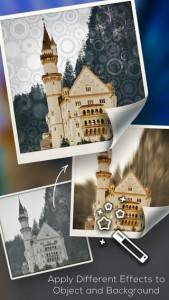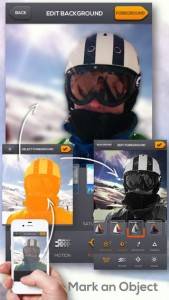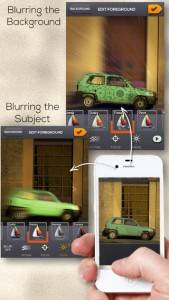Using the new Layrs App for mobile photo editing
.
 For most professional photographers utilizing a DSLR camera with numerous controls is second nature. Their camera manipulating skills are a big part of their differentiation as a creative artist.
For most professional photographers utilizing a DSLR camera with numerous controls is second nature. Their camera manipulating skills are a big part of their differentiation as a creative artist.
Two such controls that are used creatively when shooting in manual mode on a DSLR camera are shutter speed and aperture. These controls are not only an integral part of a DSLR camera, but also serve as tools that can be manipulated to create a desired visual effect. Understanding how these two controls work on a DSLR can help the mobile photographer simulate the same effect shooting with his smartphone and editing his photo with apps.
.
1. Shutter Speed and Aperture Control on a DSLR The word “photography” is derived from the Greek language: “photo” meaning “light” and “graphe” meaning “drawing”.
.
A photographer controls the “light” using a camera to create a “drawing”. This is the essence of photography.
.
 The word exposure refers to how much light is getting into the camera though the lens.
The word exposure refers to how much light is getting into the camera though the lens.
If there is too much light, a photograph will be over exposed. If there is not enough light, a photograph will be underexposed. The exposure value is the quantity of light entering the camera, a combination of the shutter speed and the aperture. The shutter is the part of the camera that opens up when taking a photo and allows light to enter the camera.
.
The shutter speed refers to how long the shutter remains open.
It is measured in seconds or fractions of a second, typically ranging from 2 seconds to 1/4000th of a second depending on the sophistication of the camera. The longer the shutter is open, the more light enters the camera. One of the main uses of the shutter speed is to capture motion. Using a very slow shutter speed, i.e. allowing the shutter to be open for a long time, allows the photographer to blur motion. Using a very fast shutter speed, i.e. allowing the shutter to be open for a very short period of time allows the photographer to freeze motion.
This can be a useful creative technique in shooting photographs. The aperture is the hole which light travels through a camera’s lens. In photography, the aperture is referred to in f-stops. The f-stop is a ratio of the focal length and the diameter of the aperture opening. The f-stop ranges from 1 to 64. The larger the f-stop number the smaller the aperture opening and the less light gets into the camera. Therefore at f.64, the aperture opening is very small and lets in little light. With a small opening, there are less optical distortions on the photograph. With less distortions, the whole image will appear sharp and in focus. With a large opening, at f.2.8 for example, parts of the image will be distorted, blurred or out of focus. The effect of changing the aperture or using different f-stop numbers is called depth of field.
By using a small aperture or f-stop, the photographer is able to have a wide depth of field with the majority of the image in focus. Using a large opening or smaller f-stop number allows an object within or section of an image to be in focus while the rest of the image is blurred. This is referred to as a narrow depth of field.
.
 Both aperture and shutter speed influence how light or dark an image is, however each setting also controls a visual effect in photography. For typical landscapes where you would want everything in focus, a small aperture opening, like f/22 should be used. For a typical portrait where you would want just the subject to be sharp, while the background being soft and out of focus an aperture of f/2.8 could be used. For capturing kids running, or a sporting event a fast shutter speed, 1/1000 sec is typical.
Both aperture and shutter speed influence how light or dark an image is, however each setting also controls a visual effect in photography. For typical landscapes where you would want everything in focus, a small aperture opening, like f/22 should be used. For a typical portrait where you would want just the subject to be sharp, while the background being soft and out of focus an aperture of f/2.8 could be used. For capturing kids running, or a sporting event a fast shutter speed, 1/1000 sec is typical.
.
To create a sense of movement in a shot, where objects are blurred, a slow shutter speed, like 1/8 sec is appropriate. Even given these general examples, ultimately, how much light is available will dictate the other setting, low light landscapes will need a very long shutter speed, bright days when blurring motion will require the smallest aperture possible. Just these two controls gives the DSLR photographer immense creative freedom. In mobile photography, the camera in a smart phone does not allow such freedom. This is where the use of apps comes into play. After shooting a photo with a smartphone, a photographer can use an app to edit image in a way that simulates the effect of adjusting aperture and shutter speed on a DSLR camera.
.
2. Aperture and Shutter Speed Using a Smartphone Camera and Editing with layrs app Recently, a new app, layrs, was introduced that allows the mobile photographer to create a photo that has the same effect as adjusting the shutter speed and the aperture on a DSLR camera.
.
Let’s look in detail at how a mobile photographer can use layrs to simulate a narrow depth of field as if using a DSLR camera. Take the image below for example, the main story is the sleeping cat on top of the cushions. The busy background is taking the attention away from the cat. To highlight the desired subject, the sleeping cat in the foreground, the technique of blurring the background as if using a narrow depth of field can be used. With a smartphone camera, a photographer can achieve the effect of a shallow depth of field by using the app, layrs, demonstrated below. The first step is to open layrs and choose the photograph from the camera roll, or just take a new photo. The desired subject is then selected with a slow sweep of a finger.
.
 The layrs app accurately recognizes the boundary of the cat on the cushions and isolates it from the background. Now the background can be edited separately from the foreground. Using the focus tool, the background can be blurred to appear less in focus while the cat remains sharp and in focus. The intensity of the blur can be adjusted from 1 to 5 simulating varying levels of depth of field. Once this is achieved, all the other tools within layrs are at your disposal – brightness, contrast, saturation, sharpening and several unique filters. The final result: the same effect of varying the aperture on a DSLR is now achieved on a mobile device using layrs!
The layrs app accurately recognizes the boundary of the cat on the cushions and isolates it from the background. Now the background can be edited separately from the foreground. Using the focus tool, the background can be blurred to appear less in focus while the cat remains sharp and in focus. The intensity of the blur can be adjusted from 1 to 5 simulating varying levels of depth of field. Once this is achieved, all the other tools within layrs are at your disposal – brightness, contrast, saturation, sharpening and several unique filters. The final result: the same effect of varying the aperture on a DSLR is now achieved on a mobile device using layrs!
.
Just as layrs can simulate the effect of adjusting the aperture on a DSLR camera using a smartphone, layrs can be used also to simulate the effect of a slow shutter speed. Let’s now look at how this effect can be achieved. Once again, the photo is taken or chosen from the camera roll. The object and desired surrounding area is accurately selected using the smart mask, a tool unique to layrs. In this case, the car and the shadow below the car is selected. Now the background and the car can be edited separately.
To create the effect of using a slow shutter speed on a moving object, the motion blur or horizontal blur feature is used on the car. This feature has varying levels from 1 to 5 to create the effect of a slow or fast moving vehicle. In addition, all of the other features of layrs can be used to brighten, saturate, sharpen, add contrast or even add a subtle or more obvious filter. The resulting effect makes a much more interesting photo. Brighter and more catchy, the photo appears as if it was taken with a slow shutter speed – the same as adjusting the shutter speed in a DSL.
.
You can download the Layrs App here!
.
@LayrsApp Team




